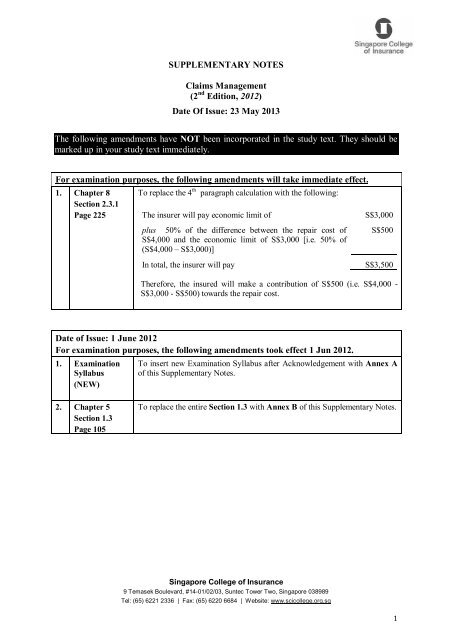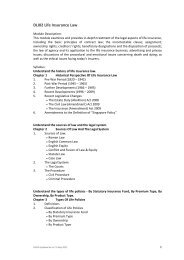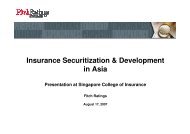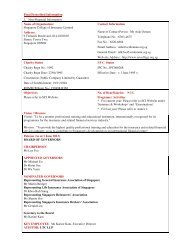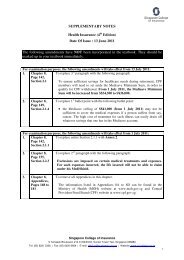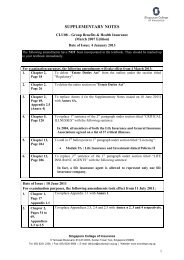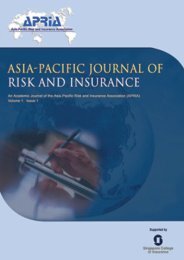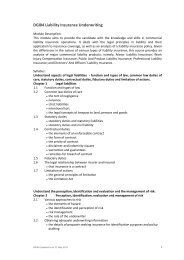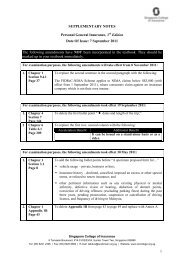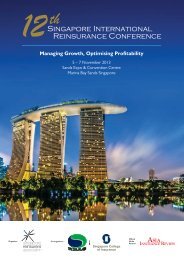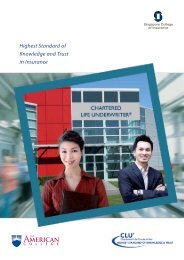Supplementary Notes - Singapore College of Insurance
Supplementary Notes - Singapore College of Insurance
Supplementary Notes - Singapore College of Insurance
Create successful ePaper yourself
Turn your PDF publications into a flip-book with our unique Google optimized e-Paper software.
SUPPLEMENTARY NOTES<br />
Claims Management<br />
(2 nd Edition, 2012)<br />
Date Of Issue: 23 May 2013<br />
The following amendments have NOT been incorporated in the study text. They should be<br />
marked up in your study text immediately.<br />
For examination purposes, the following amendments will take immediate effect.<br />
1. Chapter 8 To replace the 4 th paragraph calculation with the following:<br />
Section 2.3.1<br />
Page 225 The insurer will pay economic limit <strong>of</strong><br />
S$3,000<br />
plus 50% <strong>of</strong> the difference between the repair cost <strong>of</strong><br />
S$4,000 and the economic limit <strong>of</strong> S$3,000 [i.e. 50% <strong>of</strong><br />
(S$4,000 – S$3,000)]<br />
In total, the insurer will pay<br />
S$500<br />
S$3,500<br />
Therefore, the insured will make a contribution <strong>of</strong> S$500 (i.e. S$4,000 -<br />
S$3,000 - S$500) towards the repair cost.<br />
Date <strong>of</strong> Issue: 1 June 2012<br />
For examination purposes, the following amendments took effect 1 Jun 2012.<br />
1. Examination<br />
Syllabus<br />
(NEW)<br />
To insert new Examination Syllabus after Acknowledgement with Annex A<br />
<strong>of</strong> this <strong>Supplementary</strong> <strong>Notes</strong>.<br />
2. Chapter 5<br />
Section 1.3<br />
Page 105<br />
To replace the entire Section 1.3 with Annex B <strong>of</strong> this <strong>Supplementary</strong> <strong>Notes</strong>.<br />
<strong>Singapore</strong> <strong>College</strong> <strong>of</strong> <strong>Insurance</strong><br />
9 Temasek Boulevard, #14-01/02/03, Suntec Tower Two, <strong>Singapore</strong> 038989<br />
Tel: (65) 6221 2336 | Fax: (65) 6220 6684 | Website: www.scicollege.org.sg<br />
1
Annex A<br />
To <strong>Supplementary</strong> <strong>Notes</strong><br />
Claims Management, 2 nd Edition<br />
Date Of Issue: 1 June 2012<br />
<strong>Singapore</strong> <strong>College</strong> <strong>of</strong> <strong>Insurance</strong><br />
9 Temasek Boulevard, #14-01/02/03/04, Suntec Tower Two, <strong>Singapore</strong> 038989<br />
Tel: (65) 6221 2336 | Fax: (65) 6220 6684 | E-mail: talk2us@scidomain.org.sg | Website: www.scicollege.org.sg<br />
A1
Examination Syllabus<br />
Examination Syllabus<br />
1. Understand the claims environment<br />
1.1 Claims management strategy<br />
1.2 Claims philosophies<br />
1.3 Organisation design and structure<br />
1.3.1 Claims department within the insurer (divisional /<br />
functional / other)<br />
1.3.2 Interaction <strong>of</strong> claims department with other functions<br />
1.3.3 Internal structure <strong>of</strong> the department; job roles, teams,<br />
responsibilities, specialism<br />
1.3.4 Referral points; authorities<br />
1.3.5 The role and responsibilities <strong>of</strong> the department manager<br />
1.4 Policy interpretation<br />
1.5 Regulation and legislation<br />
1.5.1 Implication <strong>of</strong> Consumer Protection (Fair Trading) Act<br />
(Cap. 52A)<br />
1.5.2 Contract certainty<br />
2. Understand and apply claims service management practices<br />
2.1 Customer experience – expectations, satisfaction<br />
2.1.1 Ethical codes <strong>of</strong> practice<br />
2.1.2 Use <strong>of</strong> Claims service as a marketing tool<br />
2.1.3 Treating Customers Fairly<br />
2.2 Customer retention<br />
2.3 Complaints handling<br />
2.3.1 Alternative Dispute Resolution<br />
Copyright reserved by <strong>Singapore</strong> <strong>College</strong> <strong>of</strong> <strong>Insurance</strong> Limited | A2 | A2
Legal Aspects Of <strong>Insurance</strong><br />
2.4 Policyholder litigation and breach <strong>of</strong> contract<br />
2.4.1 Bad faith<br />
3. Understand and apply claims management practices<br />
3.1 Design and implementation <strong>of</strong> claims handling procedures for<br />
both first and third party<br />
3.2 Civil Procedure Rules<br />
3.3 The pre-action protocols<br />
3.4 Process review and quality management<br />
3.5 Compliance with claims procedures<br />
3.6 Claims handling operation<br />
3.6.1 Segmentation (volume and complexity)<br />
3.6.2 Authorities<br />
3.6.3 Outsourcing<br />
3.6.4 Delegated authorities<br />
3.6.5 Catastrophe management<br />
3.7 Supplier and relationship management; panels<br />
3.7.1 Loss adjusters<br />
3.7.2 Solicitors<br />
3.7.3 Suppliers <strong>of</strong> goods and services<br />
3.8 Call centre management<br />
4. Understand and apply claims technical management<br />
4.1 Reserving philosophies<br />
4.2 Interaction between claims, actuaries and underwriting<br />
4.3 Information technology<br />
A3 | Copyright reserved by <strong>Singapore</strong> <strong>College</strong> <strong>of</strong> <strong>Insurance</strong> Limited
Examination Syllabus<br />
4.4 Management information<br />
4.5 Fraudulent claims<br />
4.5.1 Ethical aspects<br />
4.6 London and Lloyd’s market<br />
4.7 Reinsurance<br />
4.8 Subrogation and recoveries<br />
4.9 International claims<br />
5. Understand and calculate the cost <strong>of</strong> management practices<br />
5.1 Cost control strategy<br />
5.1.1 Indemnity spend, handling spend and their<br />
interrelationship<br />
5.2 Estimating and reserving<br />
5.3 Leakage<br />
5.4 Cost <strong>of</strong> the claims function – internal costs, share <strong>of</strong> overheads,<br />
etc<br />
Copyright reserved by <strong>Singapore</strong> <strong>College</strong> <strong>of</strong> <strong>Insurance</strong> Limited | A4
Annex B<br />
To <strong>Supplementary</strong> <strong>Notes</strong><br />
Claims Management<br />
2 nd Edition<br />
Date Of Issue: 1 June 2012<br />
<strong>Singapore</strong> <strong>College</strong> <strong>of</strong> <strong>Insurance</strong><br />
9 Temasek Boulevard, #14-01/02/03/04, Suntec Tower Two, <strong>Singapore</strong> 038989<br />
Tel: (65) 6221 2336 | Fax: (65) 6220 6684 | E-mail: talk2us@scidomain.org.sg | Website: www.scicollege.org.sg<br />
B1
B2 | Claims Management<br />
1.3 Cost Of Claims Management<br />
In this context, “cost” refers firstly to the cost <strong>of</strong> running the claims<br />
operation, and secondly, to the cost <strong>of</strong> settling the claims by the claims<br />
department. Managing the cost means controlling the amount <strong>of</strong> money<br />
expended over a defined period <strong>of</strong> time.<br />
The operating costs are:<br />
• the cost <strong>of</strong> running the claims department itself, such as the staff<br />
remuneration <strong>of</strong> the claims department;<br />
• costs allocated to the department from costs <strong>of</strong> running the entire<br />
operation, i.e. costs incurred running the insurance company as a whole,<br />
such as IT, <strong>of</strong>fice space, and other department staff members; and<br />
• external costs, i.e. the cost <strong>of</strong> engaging service suppliers and vendors.<br />
In this section, we will consider the internal costs relating to the business.<br />
1.3.1 Internal Cost<br />
When we look at outsourcing, we say that the cost <strong>of</strong> outsourcing<br />
has to be balanced against the savings made in respect <strong>of</strong> internal<br />
costs. However, what are these costs and how do they impact on<br />
the business<br />
Every dollar taken in premium must meet the cost, not only <strong>of</strong> claims<br />
and <strong>of</strong> fees, but also <strong>of</strong> running the business. These costs include,<br />
but are not limited to:<br />
• Staff costs, including salaries, bonuses, employee benefits,<br />
employer’s contributions to the Central Provident Fund;<br />
• Corporate tax and other taxes;<br />
• Cleaning and sanitation;<br />
• Maintaining the <strong>of</strong>fice building, property, machinery and <strong>of</strong>fice<br />
equipment (e.g. company cars, photocopiers, computer system,<br />
phone system, etc.);<br />
• Utilities, including air-condition;<br />
• rentals;<br />
• Stationery, printing and mailing; and<br />
• Company insurance.<br />
In addition, if an insurer has a branch network, each branch will need<br />
to contribute a proportion <strong>of</strong> its income to the head <strong>of</strong>fice for its<br />
share <strong>of</strong> overheads. These overheads include, but are not limited to:<br />
• travel costs;<br />
• hotel costs<br />
• training;<br />
• subsistence;<br />
Copyright reserved by <strong>Singapore</strong> <strong>College</strong> <strong>of</strong> <strong>Insurance</strong> Limited
5. Claims Cost Management | B3<br />
• entertainment;<br />
• marketing;<br />
• printing;<br />
• legal fees;<br />
• human resources;<br />
• server maintenance; and<br />
• IT helpdesk.<br />
Having looked at some <strong>of</strong> the internal costs <strong>of</strong> the claims<br />
department, we will move on to consider some <strong>of</strong> the external costs.<br />
1.3.2 Fee Spend<br />
Insurers seek the service <strong>of</strong> loss adjusters and legal advisers to assist<br />
in the handling <strong>of</strong> complex or large claims. Such service providers<br />
have their own stakeholders who are running these commercial<br />
enterprises to maximise pr<strong>of</strong>itability. Therefore, it is essential that<br />
the claims manager negotiates a competitive price prior to the<br />
agreement <strong>of</strong> service rendering by such service providers, be it<br />
hourly rate or fixed fee basis.<br />
These are the costs <strong>of</strong> actually running the claims department. The<br />
other major source <strong>of</strong> expenditure is the cost <strong>of</strong> settling claims.<br />
1.3.3 Indemnity Spend<br />
Indemnity spend is the total spend by an insurer in respect <strong>of</strong><br />
payments made to indemnify policyholders following the submission<br />
<strong>of</strong> valid claims. Insurers are able to benchmark average indemnity<br />
spend for certain types <strong>of</strong> claims across the market, as well as being<br />
able to compare and contrast it in the light <strong>of</strong> different portfolios <strong>of</strong><br />
business. This is usually undertaken by reference to premium in<br />
order to calculate a loss ratio, thus:<br />
Indemnity claims spend<br />
Premium<br />
= Loss ratio<br />
1.3.4 Controlling Costs<br />
One <strong>of</strong> the roles <strong>of</strong> the claims manager is to manage the cost <strong>of</strong> the<br />
claims department. There are several ways to compare the cost <strong>of</strong><br />
managing a claims department against those <strong>of</strong> its competitors:<br />
• unit case costs, i.e. the average operational cost <strong>of</strong> handling a<br />
claim;<br />
• average time spent on one claim; and<br />
• claims expense ratio, i.e. the ratio <strong>of</strong> internal costs to premiums.<br />
As claims management is specifically interested in operational costs,<br />
it is also important to consider how to control these, through:<br />
• competent and well-trained staff;<br />
• efficient administrative support;<br />
Copyright reserved by <strong>Singapore</strong> <strong>College</strong> <strong>of</strong> <strong>Insurance</strong> Limited
B4 | Claims Management<br />
• efficient claims procedures;<br />
• efficient record-keeping;<br />
• a well-written corporate claims philosophy;<br />
• use <strong>of</strong> a quality management programme;<br />
• effective management <strong>of</strong> the claims department;<br />
• effective use <strong>of</strong> IT; and<br />
• use <strong>of</strong> outsourcing.<br />
Operational costs <strong>of</strong>ten add up to a significant outlay for the<br />
insurance company. In order to keep these costs to a minimum,<br />
there should be a constant review to incorporate potential:<br />
• restructuring;<br />
• merging;<br />
• management changes;<br />
• IT system changes;<br />
• systems and processing changes;<br />
• partial or total outsourcing <strong>of</strong> the claims function; and<br />
• changes in the make-up <strong>of</strong> the book or the nature <strong>of</strong> the risks<br />
written.<br />
The geographical structure <strong>of</strong> the company can also influence costs.<br />
A trend in recent years is to have fewer and larger cost centres.<br />
The claims manager cannot analyse the management <strong>of</strong> the<br />
operational costs <strong>of</strong> the claims department in isolation: any reduction<br />
in the operational costs can have an impact on how well it operates.<br />
A reduction may have an impact on:<br />
• how many claims are overpaid;<br />
• customer satisfaction reflected in:<br />
- reduced customer retention;<br />
- reduced customer enquiries;<br />
- damage to brand and reputation;<br />
- FIDReC adjudication fee charges as complaints increase; and<br />
• the potential for punitive costs / awards if deadlines are missed.<br />
Such effects may outweigh savings made. Conversely, an increase<br />
in operational costs - provided that they are properly targeted and<br />
can result in an improvement in areas important to the customer - is<br />
likely to have a positive impact. The claims manager needs to<br />
balance the cost <strong>of</strong> the operation against the desired level <strong>of</strong> service.<br />
A company can gain a competitive advantage by having the most<br />
efficient expense ratios. An efficient expense ratio gets the balance<br />
between cost and loss <strong>of</strong> expertise right.<br />
Copyright reserved by <strong>Singapore</strong> <strong>College</strong> <strong>of</strong> <strong>Insurance</strong> Limited
5. Claims Cost Management | B5<br />
Many insurers prefer a lower initial cost base at the outset and then<br />
try to control spend, by putting in place rigid processes via IT, audit<br />
and supervision.<br />
The importance <strong>of</strong> claims cost in the insurance industry cannot be<br />
underestimated.<br />
If the cost <strong>of</strong> claims at any point in time (including the estimated<br />
future cost) exceeds the available resources to pay such liabilities,<br />
then the insurance company is technically insolvent and must enter<br />
into insolvency. Hence, the estimation <strong>of</strong> future liabilities is just as<br />
important as the control <strong>of</strong> current claim payments.<br />
Copyright reserved by <strong>Singapore</strong> <strong>College</strong> <strong>of</strong> <strong>Insurance</strong> Limited


